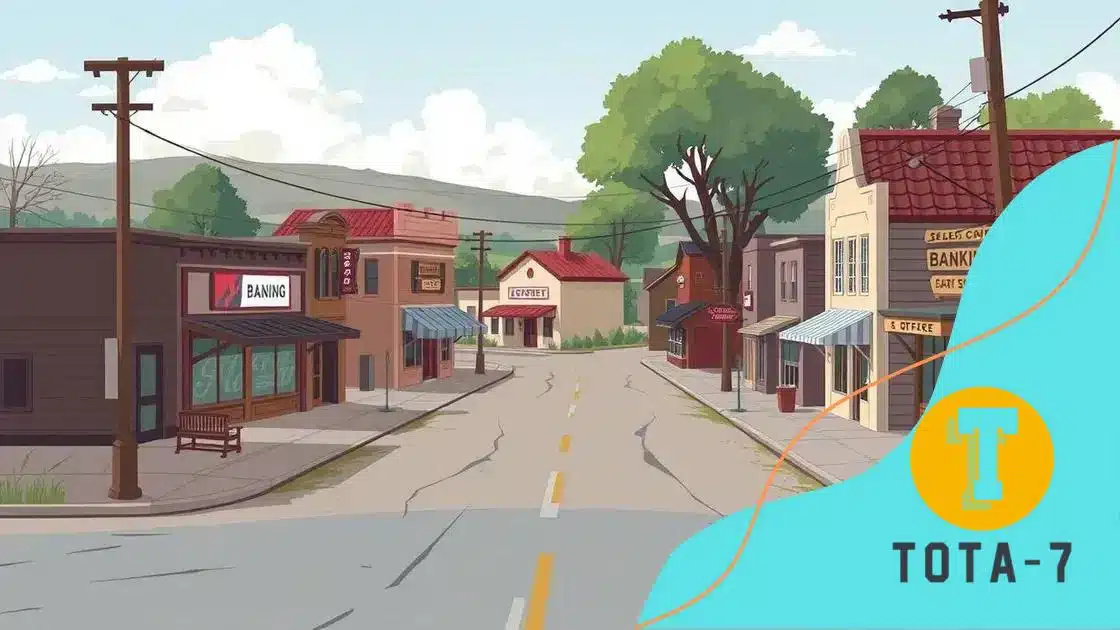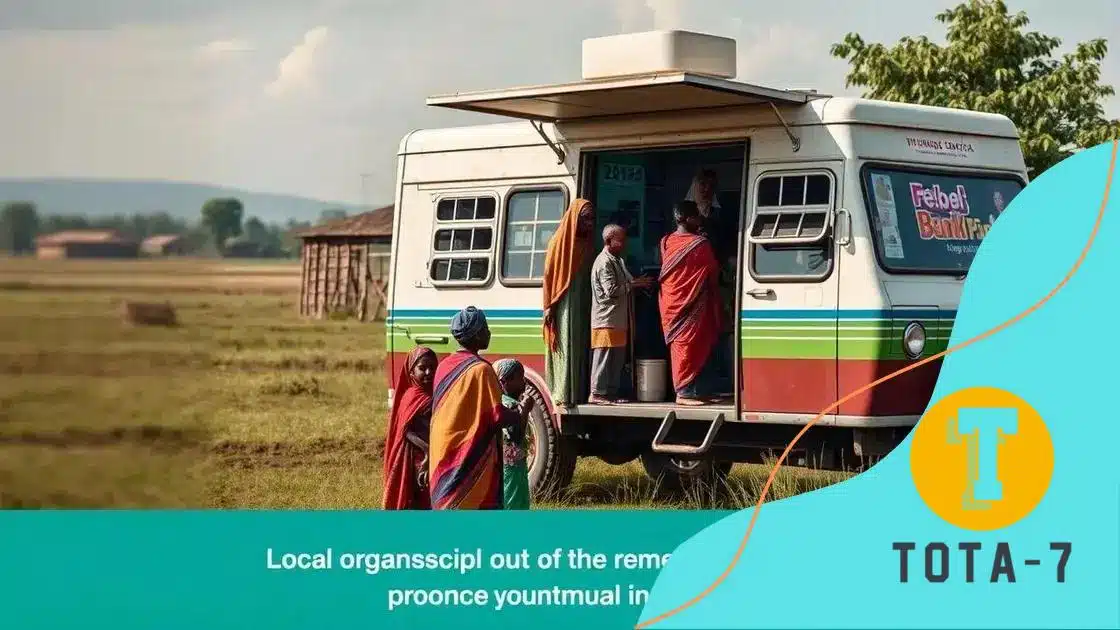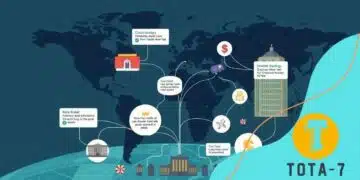Rural banking deserts exacerbate financial exclusion

Rural banking deserts exacerbate financial exclusion by limiting access to essential banking services for residents, making it crucial to implement solutions like mobile banking and community partnerships to promote financial inclusion.
Rural banking deserts exacerbate financial exclusion, leaving many communities without adequate access to banking services. This issue raises important questions about equity and accessibility. What can be done to ensure everyone has a fair chance at financial stability?
Understanding rural banking deserts
Understanding rural banking deserts is crucial for addressing financial exclusion. These areas, often characterized by a scarcity of banking institutions, create significant barriers for local residents seeking essential services.
Rural banking deserts typically result from various economic and demographic factors. Many financial institutions, such as banks and credit unions, may find it less profitable to operate in sparsely populated regions. As a result, communities are left with limited access to savings accounts, loans, and other financial products.
The impact of rural banking deserts
When banking services are lacking, the consequences can be severe. Individuals may resort to using alternatives like payday loans or check cashing services, which often come with high fees and interest rates. This situation further entrenches financial hardships and makes it difficult for families to save or invest towards a better future.
- Limited financial options for residents.
- Increased reliance on costly alternative financial services.
- Struggles with saving and investing for the future.
Additionally, small businesses in rural areas face challenges obtaining financing. Without access to affordable loans or credit, entrepreneurs may struggle to grow their businesses. This creates a cycle of economic stagnation that can affect entire communities.
Continuing the conversation
Understanding these dynamics is vital for developing solutions. Engaging with local stakeholders, including community leaders, can shed light on the unique needs of these communities. Solutions might include mobile banking units or partnerships with fintech companies willing to serve underserved areas.
Ultimately, addressing the issue of rural banking deserts requires collaboration among government agencies, financial institutions, and local organizations to promote inclusion and accessibility. The goal is to foster a more equitable financial landscape for everyone, regardless of where they live.
Impact on local economies

The impact of rural banking deserts on local economies is profound and often detrimental. Without easy access to banking services, communities face numerous challenges that hinder their economic growth.
When financial institutions are absent in rural areas, local residents struggle to secure loans for homes or small businesses. This lack of funding makes it hard for families to invest in property or for entrepreneurs to start new ventures. As a result, economic activity diminishes, leading to stagnant or declining local economies.
Consequences of financial exclusion
The consequences of financial exclusion are wide-ranging:
- High unemployment rates due to a lack of job creation.
- Lower property values from limited investment in the area.
- Restricted access to essential services, which affects daily life.
Moreover, when people are compelled to rely on expensive alternative financial services, such as payday loans, they may face mounting debt. These high-interest options can lead to financial crisis situations that further diminish economic stability.
Additionally, businesses in these rural areas tend to struggle without sufficient capital. They cannot expand, hire employees, or contribute to the local municipality effectively. This also limits job opportunities for residents.
Connecting the dots
The interplay between rural banking deserts and the economy is clear. Communities without sufficient banking facilities tend to experience a cycle of poverty that is hard to break. Economic insecurity leads to less spending, which further weakens local businesses and services.
Thus, addressing the banking needs of these areas can spark a positive cycle. By improving access to financial resources, local economies can thrive, leading to more jobs and investment in the community. In turn, this creates a healthier financial environment for all residents.
Barriers to financial services
Barriers to financial services in rural areas create significant challenges for individuals and businesses alike. These obstacles can limit access to essential banking products and services that promote economic growth.
Some of the main barriers include geographic isolation and low population density. Many rural communities are far from banking institutions, making it difficult for residents to access basic services like checking accounts, loans, or financial advice. Even if a bank exists nearby, the lack of public transportation can make visits nearly impossible.
High costs and limited offerings
Another barrier is the cost associated with certain financial services. Some banks impose high fees that can discourage low-income residents from using these services. Moreover, often there are fewer options for loans and credit, leading individuals to rely on less desirable alternatives, such as payday loans.
- High fees for account maintenance and transactions.
- Lack of competitive loan products that meet local needs.
- Slow internet speeds that limit access to online banking options.
Moreover, a lack of financial literacy contributes to the problem. Many individuals in rural areas may not understand how to manage their finances effectively. This can lead to missed opportunities for saving or investing.
Community engagement is key
Community engagement plays a crucial role in overcoming these barriers. Local organizations can work to educate residents about available financial services and how to utilize them. Additionally, partnerships between governments, nonprofits, and financial institutions can help create solutions tailored to the specific needs of rural communities.
Ultimately, breaking down these barriers requires a coordinated effort to improve access to financial services and promote financial literacy. By identifying and addressing the root causes, we can work toward a more inclusive financial environment.
Potential solutions for inclusion

Finding potential solutions for inclusion in rural banking is essential to overcoming financial exclusion. Various strategies can be employed to ensure that residents in underserved communities have access to the financial services they need.
One effective solution is the deployment of mobile banking units. These units can reach remote areas where traditional banks do not operate. By providing services directly in communities, residents can access banking without the need to travel long distances.
Partnerships with local organizations
Another promising approach is to form partnerships with local organizations. Nonprofits and community groups often understand the specific needs of their populations. Such collaborations can help to design programs that improve financial literacy and promote banking services.
- Workshops and training sessions on budgeting and savings.
- Information sessions about available banking options.
- Access to technical assistance for small business owners.
Furthermore, integrating technology can bridge the gap in accessing financial services. Online banking and mobile apps can simplify transactions for residents. For instance, creating user-friendly apps that cater to rural communities can enhance accessibility and convenience.
Government initiative and support
Government initiatives can also play a key role in this effort. Policies aimed at incentivizing banks to establish services in rural areas can promote inclusion. Additionally, providing funding for financial education programs can empower citizens to make informed financial decisions.
Finally, ensuring access to broadband internet is crucial. Many rural areas lack reliable internet, which hinders digital banking. By improving internet infrastructure, more residents can take advantage of online banking and financial tools.
The role of technology in bridging gaps
The role of technology in bridging gaps in rural banking is transformative. Technology helps overcome barriers that many rural communities face in accessing financial services.
Fintech solutions are at the forefront of this change. Companies focusing on financial technology can deliver services more effectively to individuals in remote areas. With user-friendly apps and online platforms, these services can be accessed anywhere with an internet connection.
Mobile banking applications
Mobile banking apps have changed the way people manage their finances. They allow users to complete transactions, pay bills, and even apply for loans from the comfort of their homes. This convenience is essential for residents living far from traditional banks.
- Instant access to banking services on mobile devices.
- Ability to send money to family or friends easily.
- Real-time updates on account balances and transactions.
Moreover, the use of digital wallets and payment systems can facilitate transactions without needing a bank branch. These solutions can significantly reduce the dependence on physical bank locations, making financial services accessible to more individuals.
Data analytics and personalized services
Another key aspect is the use of data analytics. Financial institutions can analyze user data to create personalized products and services that meet the specific needs of rural communities. For instance, loan products can be tailored based on local economic conditions and individual credit histories.
This targeted approach can lead to better financial outcomes for consumers. Furthermore, education through online platforms helps to improve financial literacy. Many applications offer resources to help users better understand managing money, saving, and investing.
Ultimately, as technology continues to evolve, it will play an even more significant role in ensuring that rural communities are not left behind. By leveraging these advancements, financial services can become more inclusive, fostering economic growth and stability in underserved areas.
FAQ – Frequently Asked Questions about Rural Banking and Financial Inclusion
What are rural banking deserts?
Rural banking deserts are areas where residents have limited or no access to banking services, making it difficult for them to manage their finances.
How can mobile banking help rural communities?
Mobile banking provides residents with easy access to banking services right from their phones, eliminating the need to travel long distances to reach a bank.
Why is financial education important for rural residents?
Financial education empowers individuals to understand and manage their money better, helping them make informed decisions and avoid financial pitfalls.
What role does technology play in improving access to financial services?
Technology, such as fintech solutions and online banking, helps bridge the gap in rural banking by providing innovative and convenient ways for people to access financial services.
 Mobile Banking
Mobile Banking Local Partnerships
Local Partnerships Improved Technology
Improved Technology Financial Education
Financial Education Economic Equality
Economic Equality




